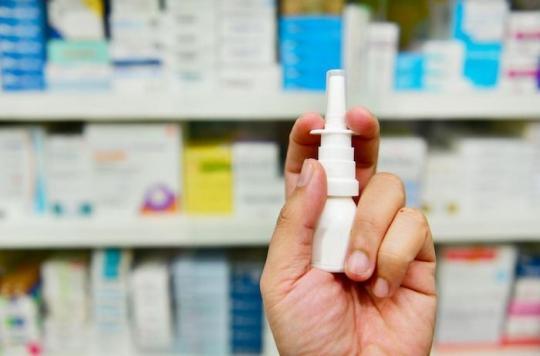A new pilot study would show the potential benefit of an esketamine derivative by the nasal route, both for preventing the risk of suicide, and for acting on mood disorders during the period of effectiveness of conventional antidepressants.

A nasal spray of ketamine in addition to conventional antidepressant therapy appears to quickly improve symptoms of depression and suicidal thoughts, according to a new study published online today in theAmerican Journal of Psychiatry (AJP).
The double-blind study compared standard antidepressant therapy combined with a nasal formulation of esketamine, a ketamine derivative, with another group of patients who received standard antidepressant therapy combined this time with placebo.
In this double-blind study of 68 patients, there was a significant improvement in the scores for depression and suicidal ideation in the esketamine group compared to the placebo group, at four hours and at 24 hours. On the other hand, the effects of esketamine are not greater than the placebo at 25 days.
A controlled but preliminary study
The aim was to assess the speed of efficacy on symptoms of severe depression, including suicide, in patients at imminent risk of suicide.
The study involved 68 participants drawn into one of two groups – either receiving esketamine (84 mg, twice a week for 4 weeks) or a placebo twice a week for four weeks. Participants in both groups continued to receive antidepressants.
The researchers looked at the effects four hours after the first treatment, 24 hours after, and 25 days after. The suicide risk measurement took into account both the patient’s and the clinician’s assessments.
Quick efficacy on mood and suicide risk
The results of the study show the effectiveness of the nasal route of administration of esketamine for effective and rapid relief of depressive and suicidal symptoms in patients who are at imminent risk of suicide. Esketamine may help fill the initial therapeutic void that exists due to the delayed effect of most antidepressants, which take about four weeks to become fully effective.
This is a simple study testing the validity of the concept and it is now time to verify these results in a more comprehensive phase 3 study.
Random nasal absorption
This phase 3 study is all the more necessary since, if the rapid effectiveness of ketamine in depression now seems to be demonstrated, the nasal route of administration is not the most reliable and not the only one: there are many- sure the intravenous route which was tested in the emergency room, but it is possible to consider the subcutaneous route, more practical.
In another recent pilot trial in drug-resistant depression, nasal esketamine is said to be accompanied by very large variations in dose, which would be the cause of major side effects. In fact, by the nasal route, absorption varies from one person to another and can vary from day to day depending on the state of the nasal mucosa and the administration technique used.
In our April issue: #ketamine shown to reduce thoughts of #suicide in major #depression; hormonal #contraception linked to suicidal thoughts; a historical analysis of Kraepelin’s nosology; and more.https://t.co/vLFCuLQfSz pic.twitter.com/Oiuhvhw8gD
– The American Journal of Psychiatry (@AmJPsychiatry) April 3, 2018
Controlling the risk of drug addiction
Another problem is the potential risk of abuse with ketamine. This potential risk of diverting prescribed intravenous ketamine for drug addiction is already known. The phase 3 study should therefore assess this risk for the nasal route, with monitoring of patient appetite and the potential use of ketamine from other sources. According to the authors, although it is the responsibility of physicians to provide a suicidal patient with all possible effective treatments, “the protection of public health is also part of the responsibilities of physicians and requires them to develop effective controls of the disease. distribution and use of ketamine ”.
These measures are not of course aimed at controlling the use of ketamine and preventing its use for beneficial purposes, but would allow the treatment to continue to be available to patients who need it while protecting the population against abuse and substance addiction.

.















